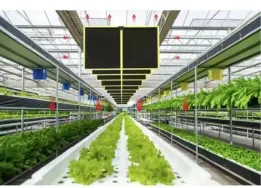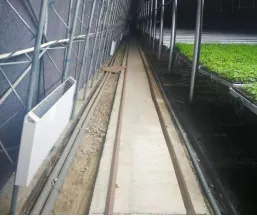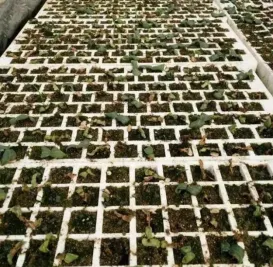Graphene Creates a “New Miracle in Agriculture” – Green Vegetables Even in Winter!
The Application of Graphene Heating Films in Soilless Cultivation
- Suspended Heating Elements Around Crops

- Wall-Mounted Heaters

Case Study: Data from a comparison between a regular greenhouse and a graphene infrared-heated greenhouse at the Vegetable Seedling Center in Xiangtan, Hunan Province, yielded the following results:

- Image 1: Over 95% of loofah seedlings grown in a regular greenhouse suffered frost damage.

- Image 2: Loofah seedlings cultivated in a graphene-heated greenhouse remained healthy.
Solving the Issue of Off-Season Frost Damage The graphene infrared-heated greenhouse can maintain a constant temperature inside, even in cold outdoor conditions, allowing crops to survive the winter. This addresses the challenge of growing off-season vegetables.
Shortening the Seedling Growth Period Using graphene infrared heating allows for earlier sowing and transplanting, speeding up the growth cycle of seedlings.
Increasing Seedling Emergence Rate Graphene infrared heating can significantly improve the emergence rate of seedlings, raising it from 80% to 98%, leading to a potential increase in yield of 30%–40%.
Reducing Pests and Diseases Infrared radiation helps reduce the occurrence of pests and diseases, decreasing the need for pesticides and fertilizers. This not only reduces labor and production costs but also promotes the growth of green, environmentally friendly seedlings.
Achieving Constant Temperature with Energy Efficiency Compared to traditional heating systems, the graphene infrared heating system can achieve more efficient temperature control, saving 50% in energy consumption. With zoned temperature control, only 3–4 hours of heating per day is needed to reach the desired temperature, significantly reducing electricity use.
Additionally, data shows that 64 graphene heating films have a total power of 14,080 watts (W). If they consume 7 kWh per hour, the total daily electricity consumption would be around 20 to 30 kWh. This energy-saving effect is particularly beneficial for agricultural production, helping to reduce costs and improve economic efficiency.
In conclusion, the application of graphene infrared heating films holds significant promise for improving agricultural productivity, reducing costs, and promoting sustainable development.
Source: Graphene News

